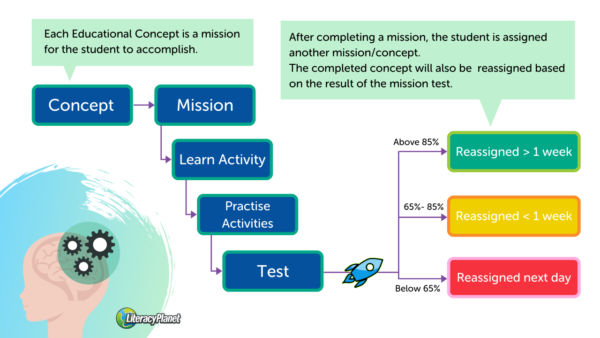
Adaptive learning is the heart of personalised English Literacy Learning with LiteracyPlanet
Adaptive Revision, or Adaptive Learning, is an evidence-based learning technique that is built into our platform to maximise student learning outcomes and reduce teachers’ content preparation workload.
LiteracyPlanet Learning Missions contain three-stages of content:
1. Learn
2. Practise
3. Test
These Missions are designed to be “bite-sized” chunks of content and can be completed by the student in an average of 10-15 minutes.
Each mission’s objective is matched to an educational outcome and is curriculum aligned.
Student test results continue to determine their personalised learning journeys. New content is shown more frequently while older and less difficult content is presented less frequently in order to exploit the spacing effect of learning. The objective is to increase retention.
As you might’ve heard, the new LiteracyPlanet will contain Educational Concepts from Years K though Year 10.
Its comprehensive Learning Map will incorporate:
- Primary and Secondary year levels
- Multiple Literacy strands
- Various learning elements per strand
- Pre and post-assessments
- Mastery outcomes
- Various teaching philosophies
- Multiple levels and outcome mastery
All this adds up to a platform that is simple to set up and enables reporting of multiple learning pathways, lesson plans and student adaptive learning journeys.
Missions are repeated based on two factors – the time between the last iteration, and the score on the assessment at the end of the learning outcome.
Why adaptive learning?
Adaptive Learning customises the student’s learning journey automatically based on what they already know and how they perform on the work they are given. It ensures:
- Struggling students are brought forward,
- Advanced students continue to be challenged, and
- All students progress through the curriculum.
On average teachers have four different levels of students in their classroom. So, by automating this process through the Adaptive Learning Map, the time teachers have to spend determining which concept needs to be taught to which student, at which time, and in which order, can be noticeably reduced.
This process removes the bulk of the content preparation workload, freeing up time for the teacher to further investigate student learning challenges, give further instruction to any class learning obstacles, and build an active learning environment that challenges students and enables them all to progress at their own pace.






